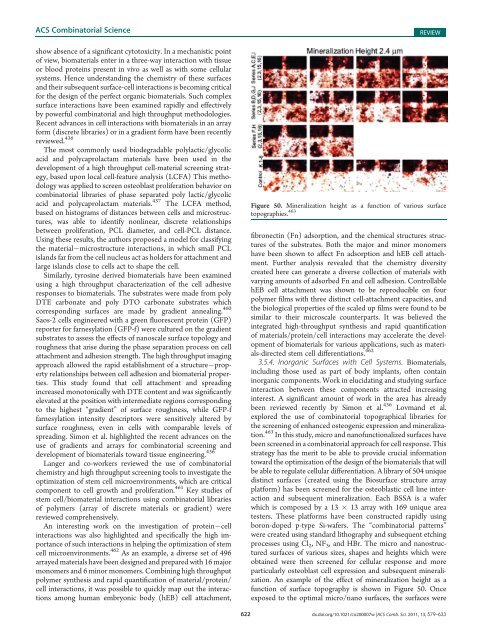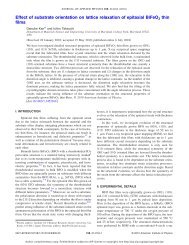Combinatorial and High-Throughput Screening of Materials ...
Combinatorial and High-Throughput Screening of Materials ...
Combinatorial and High-Throughput Screening of Materials ...
Create successful ePaper yourself
Turn your PDF publications into a flip-book with our unique Google optimized e-Paper software.
ACS <strong>Combinatorial</strong> Science<br />
show absence <strong>of</strong> a significant cytotoxicity. In a mechanistic point<br />
<strong>of</strong> view, biomaterials enter in a three-way interaction with tissue<br />
or blood proteins present in vivo as well as with some cellular<br />
systems. Hence underst<strong>and</strong>ing the chemistry <strong>of</strong> these surfaces<br />
<strong>and</strong> their subsequent surface-cell interactions is becoming critical<br />
for the design <strong>of</strong> the perfect organic biomaterials. Such complex<br />
surface interactions have been examined rapidly <strong>and</strong> effectively<br />
by powerful combinatorial <strong>and</strong> high throughput methodologies.<br />
Recent advances in cell interactions with biomaterials in an array<br />
form (discrete libraries) or in a gradient form have been recently<br />
reviewed. 436<br />
The most commonly used biodegradable polylactic/glycolic<br />
acid <strong>and</strong> polycaprolactam materials have been used in the<br />
development <strong>of</strong> a high throughput cell-material screening strategy,<br />
based upon local cell-feature analysis (LCFA) This methodology<br />
was applied to screen osteoblast proliferation behavior on<br />
combinatorial libraries <strong>of</strong> phase separated poly lactic/glycolic<br />
acid <strong>and</strong> polycaprolactam materials. 437 The LCFA method,<br />
based on histograms <strong>of</strong> distances between cells <strong>and</strong> microstructures,<br />
was able to identify nonlinear, discrete relationships<br />
between proliferation, PCL diameter, <strong>and</strong> cell-PCL distance.<br />
Using these results, the authors proposed a model for classifying<br />
the material microstructure interactions, in which small PCL<br />
isl<strong>and</strong>s far from the cell nucleus act as holders for attachment <strong>and</strong><br />
large isl<strong>and</strong>s close to cells act to shape the cell.<br />
Similarly, tyrosine derived biomaterials have been examined<br />
using a high throughput characterization <strong>of</strong> the cell adhesive<br />
responses to biomaterials. The substrates were made from poly<br />
DTE carbonate <strong>and</strong> poly DTO carbonate substrates which<br />
corresponding surfaces are made by gradient annealing. 460<br />
Saos-2 cells engineered with a green fluorescent protein (GFP)<br />
reporter for farnesylation (GFP-f) were cultured on the gradient<br />
substrates to assess the effects <strong>of</strong> nanoscale surface topology <strong>and</strong><br />
roughness that arise during the phase separation process on cell<br />
attachment <strong>and</strong> adhesion strength. The high throughput imaging<br />
approach allowed the rapid establishment <strong>of</strong> a structure property<br />
relationships between cell adhesion <strong>and</strong> biomaterial properties.<br />
This study found that cell attachment <strong>and</strong> spreading<br />
increased monotonically with DTE content <strong>and</strong> was significantly<br />
elevated at the position with intermediate regions corresponding<br />
to the highest “gradient” <strong>of</strong> surface roughness, while GFP-f<br />
farnesylation intensity descriptors were sensitively altered by<br />
surface roughness, even in cells with comparable levels <strong>of</strong><br />
spreading. Simon et al. highlighted the recent advances on the<br />
use <strong>of</strong> gradients <strong>and</strong> arrays for combinatorial screening <strong>and</strong><br />
development <strong>of</strong> biomaterials toward tissue engineering. 436<br />
Langer <strong>and</strong> co-workers reviewed the use <strong>of</strong> combinatorial<br />
chemistry <strong>and</strong> high throughput screening tools to investigate the<br />
optimization <strong>of</strong> stem cell microenvironments, which are critical<br />
component to cell growth <strong>and</strong> proliferation. 461 Key studies <strong>of</strong><br />
stem cell/biomaterial interactions using combinatorial libraries<br />
<strong>of</strong> polymers (array <strong>of</strong> discrete materials or gradient) were<br />
reviewed comprehensively.<br />
An interesting work on the investigation <strong>of</strong> protein cell<br />
interactions was also highlighted <strong>and</strong> specifically the high importance<br />
<strong>of</strong> such interactions in helping the optimization <strong>of</strong> stem<br />
cell microenvironments. 462 As an example, a diverse set <strong>of</strong> 496<br />
arrayed materials have been designed <strong>and</strong> prepared with 16 major<br />
monomers <strong>and</strong> 6 minor monomers. Combining high throughput<br />
polymer synthesis <strong>and</strong> rapid quantification <strong>of</strong> material/protein/<br />
cell interactions, it was possible to quickly map out the interactions<br />
among human embryonic body (hEB) cell attachment,<br />
REVIEW<br />
Figure 50. Mineralization height as a function <strong>of</strong> various surface<br />
topographies. 463<br />
fibronectin (Fn) adsorption, <strong>and</strong> the chemical structures structures<br />
<strong>of</strong> the substrates. Both the major <strong>and</strong> minor monomers<br />
have been shown to affect Fn adsorption <strong>and</strong> hEB cell attachment.<br />
Further analysis revealed that the chemistry diversity<br />
created here can generate a diverse collection <strong>of</strong> materials with<br />
varying amounts <strong>of</strong> adsorbed Fn <strong>and</strong> cell adhesion. Controllable<br />
hEB cell attachment was shown to be reproducible on four<br />
polymer films with three distinct cell-attachment capacities, <strong>and</strong><br />
the biological properties <strong>of</strong> the scaled up films were found to be<br />
similar to their microscale counterparts. It was believed the<br />
integrated high-throughput synthesis <strong>and</strong> rapid quantification<br />
<strong>of</strong> materials/protein/cell interactions may accelerate the development<br />
<strong>of</strong> biomaterials for various applications, such as materials-directed<br />
stem cell differentiations. 462<br />
3.5.4. Inorganic Surfaces with Cell Systems. Biomaterials,<br />
including those used as part <strong>of</strong> body implants, <strong>of</strong>ten contain<br />
inorganic components. Work in elucidating <strong>and</strong> studying surface<br />
interaction between these components attracted increasing<br />
interest. A significant amount <strong>of</strong> work in the area has already<br />
been reviewed recently by Simon et al. 436 Lovm<strong>and</strong> et al.<br />
explored the use <strong>of</strong> combinatorial topographical libraries for<br />
the screening <strong>of</strong> enhanced osteogenic expression <strong>and</strong> mineralization.<br />
463 In this study, micro <strong>and</strong> nan<strong>of</strong>unctionalized surfaces have<br />
been screened in a combinatorial approach for cell response. This<br />
strategy has the merit to be able to provide crucial information<br />
toward the optimization <strong>of</strong> the design <strong>of</strong> the biomaterials that will<br />
be able to regulate cellular differentiation. A library <strong>of</strong> 504 unique<br />
distinct surfaces (created using the Biosurface structure array<br />
platform) has been screened for the osteoblastic cell line interaction<br />
<strong>and</strong> subsequent mineralization. Each BSSA is a wafer<br />
which is composed by a 13 13 array with 169 unique area<br />
testers. These platforms have been constructed rapidly using<br />
boron-doped p-type Si-wafers. The “combinatorial patterns”<br />
were created using st<strong>and</strong>ard lithography <strong>and</strong> subsequent etching<br />
processes using Cl 2 ,NF 3 , <strong>and</strong> HBr. The micro <strong>and</strong> nanostructured<br />
surfaces <strong>of</strong> various sizes, shapes <strong>and</strong> heights which were<br />
obtained were then screened for cellular response <strong>and</strong> more<br />
particularly osteoblast cell expression <strong>and</strong> subsequent mineralization.<br />
An example <strong>of</strong> the effect <strong>of</strong> mineralization height as a<br />
function <strong>of</strong> surface topography is shown in Figure 50. Once<br />
exposed to the optimal micro/nano surfaces, the surfaces were<br />
622 dx.doi.org/10.1021/co200007w |ACS Comb. Sci. 2011, 13, 579–633












